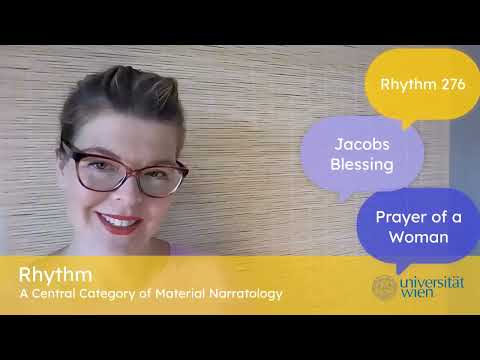 Speakers: Rabea Kohnen, Helene Eisl @heleneeisl, Elisabeth König @E_Koenig
Speakers: Rabea Kohnen, Helene Eisl @heleneeisl, Elisabeth König @E_Koenig
 Affiliation: Uni Wien
Affiliation: Uni Wien
Title: Rhythm - A Central Category of Material Narratology
Abstract (long version below): Historical narratology must take the materiality of its objects more seriously than it has done so far. Under the heading of ‘material narratology’, the paper will try this out using the central category of ‘rhythm’. We regard the category of rhythm under two perspectives: First of all as the pattern between narration and non-narration and secondly as a visual resource of the pages that establish their own spatial rhythm with the need to turn them and their own devices of giving structure to the texts by initials or marginal commentary.

 Long abstract
Long abstract
While characters are presented to experience narrative worlds and narrated events in time and space, reading itself is also a spatio-temporal experience. The narrated time and the time of narration can coincide, but also be distinguished from each other. One way to achieve this is to insert comments, digressions, lists or other non-narrative language acts. That holds especially true for medieval literature, which often alternates narration and non-narration with equal value. The resulting rhythm gains an additional layer of complexity in manuscripts that combine texts with different rhythmic qualities. As vernacular literature is most often transmitted in compilations, the resulting effects deem further investigation. The so-called Vorau manuscript dating from the 12th century is equally important and intriguing in that regard as many literary works in the German vernacular are only transmitted here. The way biblical narratives, historiographic works, courtly literature, theological reflections and works of personal piety are combined and arranged leads to a unique, yet typical rhythm of narrating and non-narrating.
Within a current research-project funded by the Austrian FWF ‘Material Narratology - Rhythm and Voice in the Vorau Manuscript 276’ we work from the assumption that historical narratology has to take the historic materiality of its object into regard to fully grasp their semantic potential and techniques. Therefore we do not only take the co-textuality within the manuscript seriously but also aim at a better understanding of the spatial rhythm as a visual resource of the (medieval) page. How the visual unity of the opened book and the rhythm of turning pages interact with structural devices like initials or marginal commentary can tell us a lot about how contemporary scribes and readers perceived the linguistic rhythm of the texts. It is our aim to bridge those two kind of rhythms – linguistic and visual – by interpreting one as a way to reflect, underline or contradict the other.
Because this way of relating narrativity and materiality is new, our study has an experimental character. Our range of methods therefore combines tools from narratology, material philology and cognitive science. First, we analyse the rhythmic structure of the linguistic text by classifying changes between narrative and non-narrative passages and noting the way they are moderated. Then we correlate this structure with the visual rhythm of the pages - what effects do the placement of differently designed initials have, which arise from the turning of pages, marginalia and addenda? The insights we gain when we look from the text to the page are then juxtaposed with insights that follow an opposite logic of enquiry. The independent visual effect of the pages of handwriting is analysed using the methodical frame-work of eye-tracking. In order to grasp the specificity of the Vorau manuscript more precisely, we will also carry out comparative analyses with several manuscripts in the direct vicinity of its origin.
In our paper we will show how the linguistic rhythm created by the different experiences of time created by narrating and non-narrating interacts with the spatial rhythm of the pages in two case studies. The first case study will deal with the end of the vernacular part of the manuscript with the fragmental “Gebet einer Frau” and the beginning of the Latin “Gesta Friderici”, focusing on the change in visual rhythm, the resulting performance and the semantic reorientation within these moments of irritation. The second case study deals with an example from the “Vorauer Bücher Mose”, more precisely the blessing which Jakob gives to his sons. This text section is predestined to examine the rhythm of narration and non-narration, supplemented by various commentaries and all of this with regard to perception by different audiences. Rhythm therefore is the driving force behind making a text accessible to different layers of readers.
In our paper, then, we will use the example of the Vorau manuscript from the 12th century to show how the linguistic rhythm of texts - understood here as the change of narrativity - interacts with the visual rhythm of the written page, thus linking the two movements of material philology and narratology, which have so far been separate in research, on the basis of empirical studies of the reading of written books

